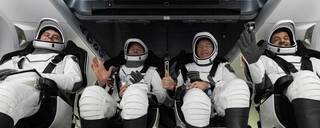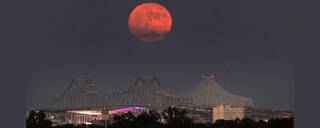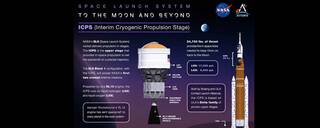Week of September 4 – September 8, 2023.
NASA’s SpaceX Crew-6 Safely Returns to Earth Near Florida Coast
After splashing down safely in a SpaceX Dragon spacecraft off the coast of Jacksonville, Florida early Monday morning, NASA’s SpaceX Crew-6 completed the agency’s sixth commercial crew rotation mission to the International Space Station. The international crew of four spent 186 days in orbit. NASA astronauts Stephen Bowen and Woody Hoburg, as well as UAE (United Arab Emirates) astronaut Sultan Alneyadi and Roscosmos cosmonaut Andrey Fedyaev, returned to Earth at 12:17 a.m. EDT. Teams aboard SpaceX recovery vessels retrieved the spacecraft and its crew. After returning to shore, the crew will fly to NASA’s Johnson Space Center in Houston.
NASA Photographer Captures Super ‘Blue Moon’ Rising Over New Orleans
A super blue moon glows above the Mississippi River and Crescent City Connection Bridge in New Orleans, Aug. 30. The full moon is “super” because its orbit is slightly closer to Earth, making it appear slightly brighter and larger than a regular full moon. It’s “blue” because it’s the second full moon in a month. About 25% of all full moons are supermoons, but only 3% of full moons are blue moons. The Moon tends to have a more yellow or orange hue when it’s low in the sky, compared to when it’s high overhead. This happens because the Moon’s light travels a longer distance through the atmosphere. Read this article to learn more about super blue moons. New Orleans is home to NASA’s Michoud Assembly Facility, where stages for NASA’s SLS (Space Launch System) rocket and structures for Orion spacecraft are produced for the Artemis missions.
NASA Completes Last OSIRIS-REx Test Before Asteroid Sample Delivery
A team led by NASA in Utah’s West Desert is in the final stages of preparing for the arrival of the first U.S. asteroid sample – slated to land on Earth in September. A mockup of NASA’s OSIRIS-REx (Origins, Spectral Interpretation, Resource Identification, and Security–Regolith Explorer) sample capsule was dropped Wednesday from an aircraft and landed at the drop zone at the Department of Defense’s Utah Test and Training Range in the desert outside Salt Lake City. This was part of the mission’s final major test prior to arrival of the actual capsule on Sept. 24 with its sample of asteroid Bennu, collected in space almost three years ago. “We are now mere weeks away from receiving a piece of solar system history on Earth, and this successful drop test ensures we’re ready,” said Nicola Fox, associate administrator of NASA’s Science Mission Directorate in Washington. “Pristine material from asteroid Bennu will help shed light on the formation of our solar system 4.5 billion years ago, and perhaps even on how life on Earth began.” This drop test follows a series of earlier rehearsals – capsule recovery, spacecraft engineering operations, and sample curation procedures – conducted earlier this spring and summer.
NASA’s SLS Mega Rocket: What Is the ICPS?
NASA’s SLS (Space Launch System) rocket’s ICPS (interim cryogenic propulsion stage), with its single RL10 engine, produces 24,750 pounds of thrust to provide in-space propulsion for the agency’s Artemis II and III missions, the first crewed missions under Artemis. Like the mega rocket’s core stage, the ICPS uses liquid hydrogen and liquid oxygen to power its RL10 engine, manufactured by Aerojet Rocketdyne, an L3Harris Technologies company. The ICPS is built by ULA (United Launch Alliance) and Boeing. In addition to providing in-space propulsion, the ICPS also contains avionics to fly the mission after core stage separation until NASA’s Orion spacecraft separates from the ICPS to venture to the Moon.
El Gordo: A Galaxy Cluster That Pushes the Limits
When astronomers discovered the galaxy cluster ACT-CL J0102-4915 in 2012 with NASA’s Chandra X-ray Observatory and ground-based optical telescopes, they nicknamed it “El Gordo” (Spanish for the “Fat One”) because of its gigantic mass. Scientists estimate that El Gordo contains as much as 3 million billion (3,000,000,000,000,000) times the mass of the Sun. Thanks to its heft, El Gordo acts as a natural lens, distorting the light from more distant objects behind it through a process known as gravitational lensing. A new composite image of El Gordo shows the diffuse, superheated gas in the cluster observed in X-rays from Chandra (blue) that have been combined with a new infrared image from NASA’s James Webb Space Telescope (red, green, and blue). Webb’s image shows galaxies in El Gordo plus background galaxies located further away from Earth.
For more information or to learn about other happenings at NASA’s Marshall Space Flight Center, visit NASA Marshall. For past issues of the ICYMI newsletter, click here.
































